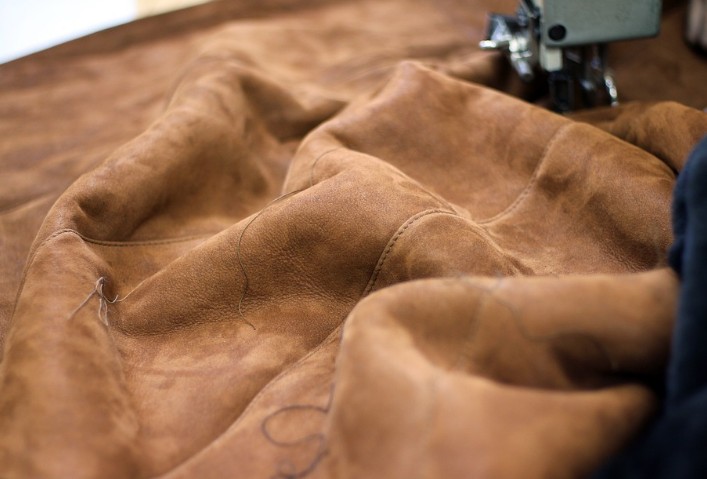New sewing project, new needle. Make this a rule for yourself. A dull, bent, or simply old sewing machine needle can easily cause your stitches to skip. Sewing machine needles can become dull after about 7 hours of use. Ensure that your needle is fully inserted at the same time. If the screw is not completely loosened before inserting, your needle may be too low. This can actually harm your sewing machine in addition to causing stitches to skip.
The most frequent reasons why stitches skip and how to fix them are listed below.
Replace a Bad Needle
An issue with the sewing machine needle is the most frequent reason for a sewing machine to skip stitches. Even if the bend is not visible, the needle might be slightly bent. It might have a dull point from use, or it might have a nick in it. The sewing machine’s needle, which is the most affordable and replaceable component, is a consumable. A new needle for your sewing machine, one that is the proper size for the fabric you are sewing, should be your first line of defense against skipping stitches.
Use the Correct Needle
Anyone who enjoys cooking is aware that there are different pans and ingredients. The same is true of your sewing supplies. Using the incorrect kind of sewing machine needle can also result in skipped stitches. While woven fabrics should be sewn with a sharp or all-purpose needle, knit fabrics should be stitched with a ballpoint or stretch needle. There are numerous specialty sewing machine needles available that are made for a particular type of fabric, and you may need to combine a specialty needle with the material you are sewing. You might need to spend money on a leather sewing machine needle if you plan to sew leather. To avoid frustration, you can quickly educate yourself and learn everything there is to know about sewing machine needles.

Use Better Thread
Always take into account the thread quality. Microscope images of the various kinds of sewing thread might persuade people that there is a difference in thread quality, despite the fact that many people hold this belief.
Even though it can be difficult, your machine may still be able to use specialty thread if you have skipped stitches while using it.
Adjust the Sewing Machine Tension
You will need to adjust your sewing machine tension if you notice that the stitching is different on the top and bottom of the fabric. The best place to learn how to change the tension on your sewing machine is the manual that came with it. If you’ve misplaced your printed copy of the manual for your sewing machine, you can almost always find it online. To solve issues and get the most out of your sewing machine, it is beneficial to keep the manual nearby.
How to Check Your Sewing Machine
Thread Check:
Is your machine properly threaded?
- Rethread the machine at the first indication of skipped stitches, following all of the thread guides and making sure the presser foot is up each time you thread the needle.
Are you using good thread?
- When selecting thread for your machine, it’s important to pick a high-quality thread, like our Gutermann Thread. Less fuzzy thread that has been wound properly, has a consistent color, and is free of any damage will be less likely to break or cause problems when being sewn.
Are the thread and needle the same size?
- For the best results when sewing, you must use the proper size needle and thread for your fabric; both the needle and thread should work well together.
Machine Check:
Is your use of fabric and tension a good match?
- Your tension may be too high, which would cause skipped stitches. Experiment by adjusting your tension dial on your machine to see if that’s the root of the problem. If necessary, adjust the tension on your bobbin case as well.
Do you move too quickly or are you pulling the fabric too tightly?
- If you notice that your sewing machine is skipping stitches, try to relax your hold on the machine or proceed more slowly to see if this quick fix can resolve the issue.
Are you using a properly wound bobbin?
- Make sure the bobbin is wound around the spool in a tight, orderly manner. Skipped stitches may result from a bobbin that isn’t tightly woven.
Needle Check:
Are you sure your needle is straight and not bent?
- Skip stitches may result from a dull, bent, or damaged needle. You may not see visible issues with your needle, but try replacing the needle to see if your skipped stitches subside.
Does your needle fit the fabric you’re sewing on properly?
- The choice of the proper needle can make the difference between skipped and complete stitches. Finding the best needle for each project will increase the quantity of goods you produce overall and the durability of your equipment. Needles come in various sizes and levels of sharpness.
What Are Three Possible Causes for Skipped Stitches in a Seam?
- Poor threading of the machine
- Incorrect needle height
- Not threaded properly the machine
Skipped stitches can be caused by improper threading, the wrong needle height, or even by the machine itself not being properly threaded. A machine that is improperly threaded might skip stitches because it can’t grab the bobbin thread to pull a stitch through. A too-low needle may also prevent a stitch from being sewn into the fabric.
Skipped stitches can happen if a presser foot is not properly positioned on the fabric. No matter what caused the seam to have missed stitches, they should be permanently removed and re-sewn as soon as possible to ensure the garment keeps its shape and durability without issues in the future.
Additionally, use a seam ripper to remove the stitches before pressing the new seams with a pressing iron set to high heat if your seams continue to fall apart despite your efforts to remove and resew them. In order to achieve even more durable stitching and reduce thread breakage, press your seams after sewing to help set your stitches.
Why is My Sewing Machine Skipping Stitches on Thick Fabric?
Let’s first try to narrow down the potential causes of the problem and troubleshoot it.
When your sewing machine skips stitches when sewing thick fabrics, there is a problem. If you avoid skipping stitches and use the same fabric thickness, your sewing needle or thread is broken. You must inspect your needle for any nicks or burrs.
Before inspecting for damage, clean your needle because a dirty needle can result in skipped stitches. You might need to replace the needle even if it is clean and free of damage. Additionally, the thread tension needs to be examined and, if necessary, adjusted.
If the timing and pressure of the foot are factory-set, you won’t be able to change them, but you can watch this video to learn how to sew through thick material.
Why Does My Sewing Machine Skip Stitches on Stretch Fabric?
Skipped stitches are just one of the many problems that can arise when sewing on stretch fabrics. Use a ballpoint needle and a stitch length of 1.5 or less whenever you are sewing with a stretch fabric.
Additionally, be careful to hold the fabric firmly without stretching it too thin, as doing so could result in skipped stitches. Try adjusting the bobbin case tension in a large zigzag setting by moving the wheel along the thread tension scale until the desired results are obtained.
Worst Case Scenario: Maintenance Time
If you’ve checked every area of your embroidery machine that you can access and your skipped stitches problem persists, it might be time for a trip to your local embroidery machine repair tech.
Even though a service call can be pricey, a technician is usually better equipped to handle problems with the machine’s inner workings or timing of the embroidery.
Conclusion
One of the most prevalent issues with sewing machines is the ability to skip stitches. It can be annoying and frustrating, but there are only a few underlying reasons for it. Before anything else, make sure you’re using fabric-appropriate, high-quality thread. Polyester is preferable to cotton because it is more enduring and less likely to stretch.
Undoubtedly, skipped stitches are annoying, but there’s no reason to let them persist. Don’t let skipped stitches cause your project to be delayed because you can usually solve the problem using our advice. Once the issue has been located, you can immediately resume sewing.
Have you ever been stuck in the following problems with sewing machines? Read & Learn more together!
- Why My Sewing Machine Not Making Straight Stitches – How to Adjust
- How to Change Sewing Machine Needle With Simple Methods
- How To Clean Your Sewing Machine With Simple Steps
- Why Does My Sewing Machine Keep Jamming – How To Solve
- What is a Serger Sewing Machine – Everything You Should Know
- How To Hem Pants By Sewing Machine In The Easy Way
- How to Use Brother Sewing Machine – Beginner Guide 2022
- How To Use A Sewing Machine: Step-By-Step Instruction
- How To Thread A Sewing Machine: Step-By-Step Instruction











